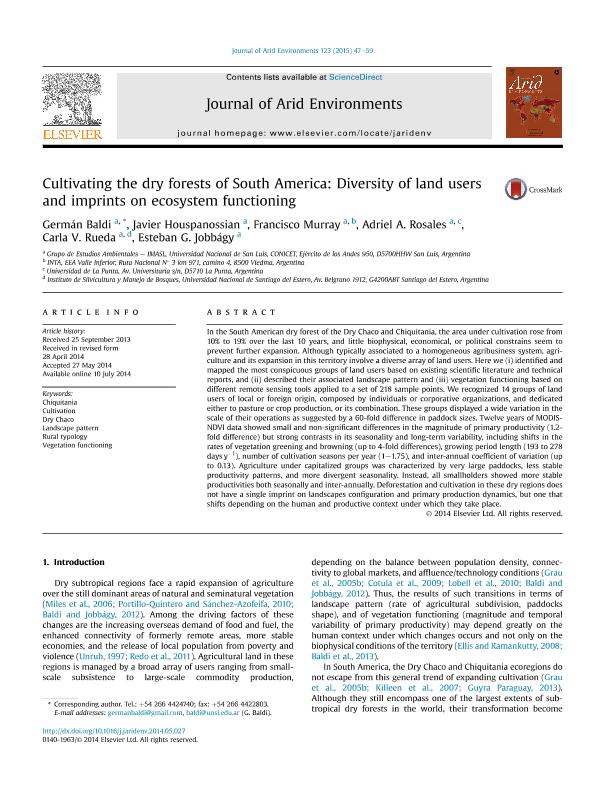Artículo
Cultivating the dry forests of South America: Diversity of land users and imprints on ecosystem functioning
Baldi, Germán ; Houspanossian, Javier
; Houspanossian, Javier ; Murray, Francisco; Rosales, Adriel A.; Rueda, Carla Vanezza
; Murray, Francisco; Rosales, Adriel A.; Rueda, Carla Vanezza ; Jobbagy Gampel, Esteban Gabriel
; Jobbagy Gampel, Esteban Gabriel
 ; Houspanossian, Javier
; Houspanossian, Javier ; Murray, Francisco; Rosales, Adriel A.; Rueda, Carla Vanezza
; Murray, Francisco; Rosales, Adriel A.; Rueda, Carla Vanezza ; Jobbagy Gampel, Esteban Gabriel
; Jobbagy Gampel, Esteban Gabriel
Fecha de publicación:
01/2014
Editorial:
Elsevier
Revista:
Journal of Arid Environments
ISSN:
0140-1963
Idioma:
Inglés
Tipo de recurso:
Artículo publicado
Clasificación temática:
Resumen
In the South American dry forest of the Dry Chaco and Chiquitania, the area under cultivation rose from 10% to 19% over the last ten years, and little biophysical, economical, or political constrains seem to prevent further expansion. Although typically associated to a homogeneous agribusiness system, agriculture and its expansion in this territory involve a diverse array of land users. Here we (i) identified and mapped the most conspicuous groups of land users based on existing scientific literature and technical reports, and (ii) described their associated landscape pattern and (iii) vegetation functioning based on different remote sensing tools applied to a set of 218 sample points. We recognized 14 groups of land users of local or foreign origin, composed by individuals or corporative organizations, and dedicated to farming, ranching or both. These groups displayed a wide variation in the scale of their operations as suggested by a 60-fold difference in paddock sizes. Twelve years of MODIS-NDVI data showed small and non- significant differences in the magnitude of primary productivity (1.2 fold-difference) but strong contrasts in its seasonality and long-term variability, including shifts in the rates of vegetation greening and browning (up to 4 fold-differences), growing period length (193 to 278 days y-1)number of cultivation seasons per year (1 to 1.75), and inter-annual coefficient of variation (up to 0.13). Agriculture under capitalized groups was characterized by very large paddocks, less stable productivity patterns, and more divergent seasonality. Instead, all smallholders showed more stable productivities both seasonally and inter-annually. Deforestation and cultivation in these dry regions does not have a single imprint on landscapes configuration and primary production dynamics, but one that shifts depending on the human and productive context under which they take place.
Palabras clave:
Dry Chaco
,
Chiquitania
,
Cultivation
,
Rural Typology
Archivos asociados
Licencia
Identificadores
Colecciones
Articulos(IMASL)
Articulos de INST. DE MATEMATICA APLICADA DE SAN LUIS
Articulos de INST. DE MATEMATICA APLICADA DE SAN LUIS
Citación
Jobbagy Gampel, Esteban Gabriel; Rosales, Adriel A.; Murray, Francisco; Houspanossian, Javier; Baldi, Germán; Rueda, Carla Vanezza; et al.; Cultivating the dry forests of South America: Diversity of land users and imprints on ecosystem functioning; Elsevier; Journal of Arid Environments; 123; 1-2014; 47-59
Compartir
Altmétricas



